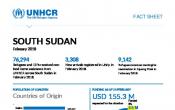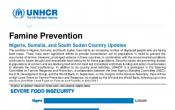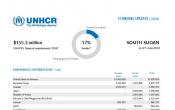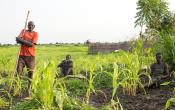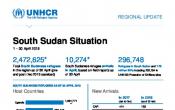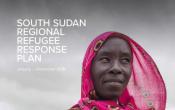South Sudan
Operation: South Sudan
Location
{"longitude":30,"latitude":7,"zoom_level":0,"iso_codes":"'SSD'"}
By clicking on the icons on the map, additional information is displayed.
Key Figures
| 2017 year-end results | |
| 717,000 | IDPs reached through protection interventions |
| 184,630 | tree seedlings were planted as part of a peaceful coexistence strategy |
| 57,000 | internally displaced households with specific vulnerabilities were assisted with core relief items and emergency shelters |
| 40,870 | refugee children enrolled in primary school and 3,450 in secondary school |
| 19,600 | refugee ID cards were issued |
| 18,420 | refugee families received livelihood kits |
| 1,750 | SGBV cases reported to UNHCR received medical, legal and psychosocial support and/or livelihood assistance |
| 2018 planning figures | |
| 90% | of refugee children with acute malnutrition will be supported |
| 85% | of refugee households will receive durable shelters |
| 80% | of school age refugee children will be enrolled in primary education |
| 80% | of households will have an individual latrine |
| 44,400 | vulnerable IDP households will receive core-relief items |
| 11,750 | displaced people with specific needs will receive support |
Latest Updates and Related Links
People of Concern
40%
Increase in
2016
2016
| 2016 | 2,870,538 |
| 2015 | 2,054,441 |
| 2014 | 2,093,729 |

[["Refugees",262560],["Asylum-seekers",1792],["IDPs",1853924],["Returned IDPs",752261],["Returned refugees",1]]
Loading ...
South Sudan
< Back
2017
{"categories":[2013,2014,2015,2016,2017,2018],"budget":[220.15274604,423.03014037,413.880856341,275.66821274,171.67261918,155.2873228],"expenditure":[159.68388729,142.04241824,140.46294415,126.30817887,131.89496719,null]}
{"categories":[2013,2014,2015,2016,2017,2018],"p1":[169.56500337,190.77653836,185.326305374,167.85975155,130.87408024,120.07758228],"p2":[9.31867217,8.77186352,6.53999141,4.79579352,1.49549201,1.505682],"p3":[10.46680187,null,null,null,null,null],"p4":[30.80226863,223.48173849,222.014559557,103.01266767,39.30304693,33.70405852]}
{"categories":[2013,2014,2015,2016,2017,2018],"p1":[140.4070933,86.74189326,96.29588561,87.87085463,105.18668788,null],"p2":[4.03534842,3.76620376,2.11256854,2.54706187,0.83805353,null],"p3":[4.86436034,null,null,null,null,null],"p4":[10.37708523,51.53432122,42.05449,35.89026237,25.87022578,null]}
Loading ...
CHOOSE A YEAR
- 2014
- 2015
- 2016
- 2017
- 2018
Operational context
Despite the creation of the High-Level Revitalization Forum (HLRF) in June 2017 and the official launch of the President Salva Kiir’s initiative for a nation-wide dialogue in May 2017, the humanitarian situation in South Sudan remained highly volatile with the conflict spreading across areas that had previously been relatively stable. The Transitional Government of National Unity (TGoNU) was unable to ensure security, and the economic difficulties facing the country remained with the inflation rate tripling in 2017. Also, on 21 December 2017, HLRF parties signed yet another Agreement on Cessation of Hostilities, Protection of Civilians and Humanitarian Access at the end of the first HLRF phase. This action has required parties to cease all hostile military actions by 24 December 2017, but suffered immediate violations in a number of locations. The proliferation of arms across the country and maintenance of the civilian character of asylum in the camps remained challenging.While South Sudan maintained an open door policy for refugee arrivals, the asylum conditions were affected by the conflict, especially in the greater Equatoria. UNHCR had no access to Lasu settlement in 2017 but was able to assist those in Yei town. The year also witnessed violent clashes between two refugee tribes in refugee camps, as a result 12,600 refugees were internally relocated by UNHCR across four camps in Maban. The situation remained tense but stabilized with UNHCR-led peace committees.
Population trends
South Sudan hosted some 283,000 refugees (82 per cent of which are women and children) with 92 per cent from Sudan, 5 per cent from the Democratic Republic of the Congo, two per cent from Ethiopia and one percent from the Central African Republic. Some 90 per cent of refugees reside in camps in the north of the country.The number of IDPs in the country grew to more than 1.9 million compared to 1.8 million in 2016. Some 209,000 IDPs are hosted in the UNMISS Protection of Civilian (POC) sites while the vast majority of them stayed with host communities and spontaneous settlements, many in remote areas with limited infrastructure and accessibility and with major security challenges.
The refugee arrivals in 2017 totaled some 16,200 individuals, an increase of 36 per cent when compared with 2016, mostly due to intensified fighting combined with food insecurity in South Kordofan.
Key achievements
In cooperation with the Government and partners, UNHCR continued to deliver protection and assistance to over 283,000 refugees, supported efforts to prevent statelessness, and rendered protection-centered interventions for IDPs.Refugee response:
- Protection activities focused on reception, registration and documentation: 52,884 refugee identity documents including 19,602 refugee ID cards were issued. Appropriate responses were provided to nearly 2,000 unaccompanied children and some 1,760 reported cases of sexual and gender-based violence incidents, according to needs including medical, legal and psychosocial support and - at the rehabilitation phase – livelihood assistance.
- Awareness-raising campaigns on the importance of the civilian character of the camps were carried out, and community participation and peaceful co-existence with the host communities were promoted.
- Essential services such as WASH, health, nutrition, education were provided in all refugee camps where access remained permissible. The health, nutrition and WASH indicators were applied according to relevant standards. Some 18,400 refugees received livelihood kits and agricultural land was secured for agricultural activities of refugees.
- Yida exit strategy continued to be a priority with the relocation of some 16,800 refugees to Pamir and Ajoung Thok in 2017.
- UNHCR continued to lead the Protection Cluster and co-lead the Camp Coordination and Camp Management (CCCM) Cluster for the IDP response. UNHCR provided protection assistance through outreach, strengthening of community structures, counseling, identification of people with specific needs, targeted material assistance and/or referrals. UNHCR conducted almost 500 protection assessments, facilitated training on the prevention of sexual and gender-based violence to 2,160 IDPs and organised 220 awareness-raising sessions. Close to 57,000 IDPs with specific vulnerabilities received material assistance including core-relief items and emergency shelters. Overall, some 717,000 IDPs were reached in 2017.
- Nationality certificates were issued to close to 800 individuals in close cooperation with the Directorate of Nationality, Passports and Immigration (DNPI). Since 2012, UNHCR has helped more than 12,000 individuals at risk of statelessness obtain nationality certificates.
Unmet needs
Substantial gaps remain in meeting the protection and assistance needs of refugees, IDPs and persons at risk of statelessness, due to general insecurity across the country, lack of basic infrastructure/services and resource constraints.- Access to justice in most of the locations remains a challenge, due to the absence of adequate formal judicial structures.
- Gaps remained in the improvement of emergency shelters and other camp facilities: over 60 per cent of refugees remained in need of transitional shelters; teacher/pupil ratio persisted at 1:110. Solarisation and boreholes need to be increased. More robust livelihoods and self-reliance interventions are required.
- Critical gaps remained in the implementation of IDP protection outreach activities, including profiling, focus group discussions, identification of, and tailored response to, vulnerable people and support to existing community structures. Interventions in addressing SGBV were not able to meet the tremendous needs, due to limited local capacity to respond to the needs of SGBV survivors and populations at risk in the capital, and non-existent in other parts of the country as well as lack of legal remedies to redress the rights of SGBV survivors.
Working environment
The operational environment in South Sudan remains unpredictable with ongoing conflict and localized fighting, despite the relative stability that is restored in the capital Juba, following the series of violent clashes which took place in July 2016. Despite these challenges, South Sudan maintains an open door policy for refugees and continues to receive new arrivals. UNHCR is able to provide protection and assistance to persons of concern, although there are logistical and security challenges in accessing some field locations due to their geographical remoteness.Key priorities
• UNHCR’s overarching priority in South Sudan is set to continue with provision of humanitarian assistance and leadership on Protection, while strengthening the self-reliance capacity of displaced people with a particular focus on the vulnerable.• For refugees, UNHCR will increase investments in livelihoods, youth projects, education and community mobilization to augment self-reliance and resilience, as well as to facilitate peaceful coexistence with host communities. Assistance will be provided to new arrivals, and UNHCR will support authorities in developing national asylum systems.
• For IDPs, UNHCR will continue to provide leadership on Protection through engagement in protection interventions/delivery and coordination, provision of quality information and analysis of protection needs of displaced people. UNHCR will identify and provide basic assistance to the most vulnerable, working in partnership with communities to increase safety and facilitate solutions where feasible.
• UNHCR will support persons at risk of statelessness to have access to documentation and assist national institutional development.
Critical gaps:
Seventy per cent of refugees remain in emergency shelters even after many years of displacement; and it is estimated that only 45 per cent of boreholes will be equipped with solar energy equipment, despite the proven value of this equipment for business continuity and cost-effectiveness. Gaps also remain in improving access to, and the improved quality of, education for refugees. Further investment is needed in order to carry out environmental protection activities and peace-building with host communities.
In terms of IDPs, challenges in access continue to affect UNHCR’s ability to improve its protection outreach and response. UNHCR works in a limited number of priority locations, only focusing on the most vulnerable people among large displaced populations.
